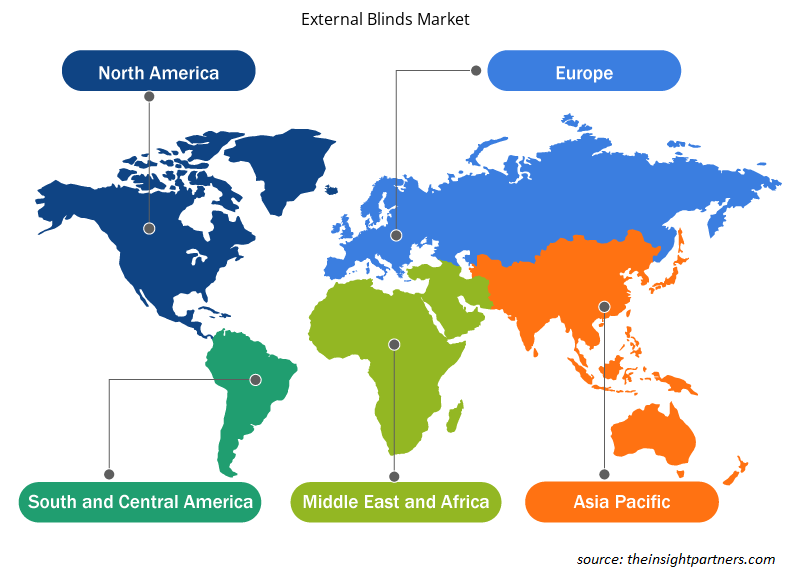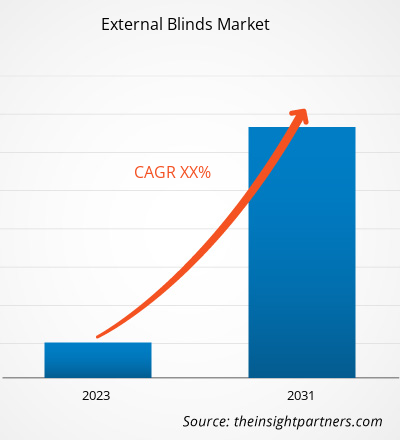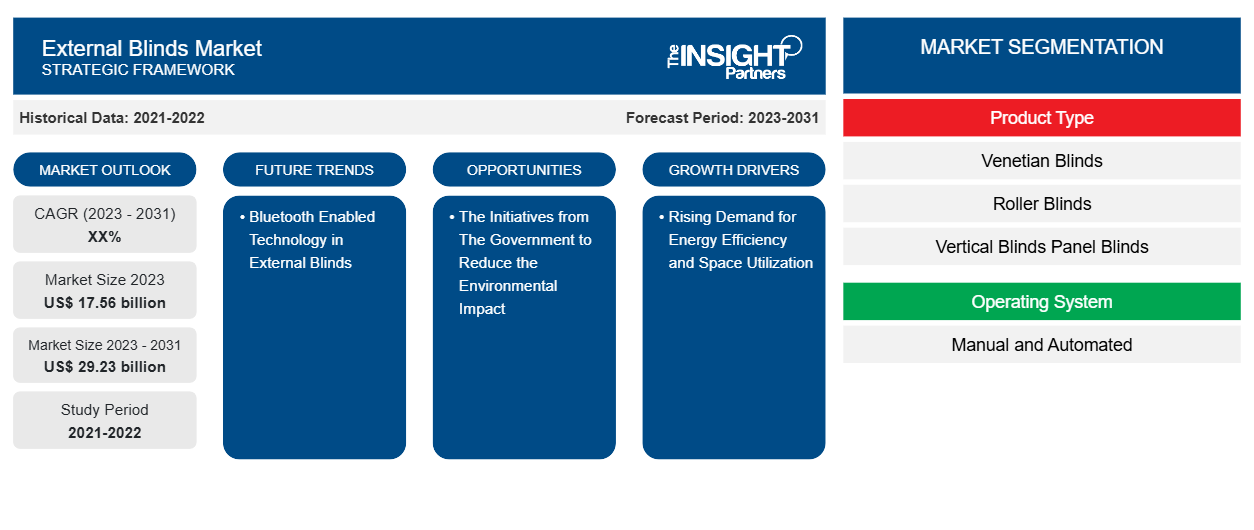Si prevede che il mercato delle tende esterne raggiungerà i 29,23 miliardi di dollari entro il 2031, rispetto ai 17,56 miliardi di dollari del 2023. La crescente domanda di gadget correlati alla domotica intelligente e di sicurezza energetica efficiente in casa, unita alla rapida urbanizzazione e all'aumento del reddito disponibile tra i consumatori, sono i fattori principali attribuiti alla domanda di tende esterne, che guiderà la crescita del mercato nei prossimi anni.
Analisi di mercato delle tende esterne
I principali stakeholder nell'ecosistema del mercato globale delle tende esterne includono i fornitori di tende esterne e gli utenti finali. La crescente domanda di efficienza energetica e massimizzazione dello spazio, le politiche governative favorevoli per promuovere l'iniziativa di edilizia ecologica e la crescente consapevolezza tra i consumatori per il miglioramento delle case a risparmio energetico, questi fattori hanno accelerato l'ingresso dei produttori di tende esterne nel mercato. Alcuni dei principali fornitori/sviluppatori sono WAREMA Renkhoff, Evaya, Mac Blinds, Tropic'l Blinds Pty Ltd, Serge Ferrari SAS, ROMA KG, PHOENIX INTERIOR DESIGN, Skyshade, ROLTEK doo, Blinds by Ad., Vista e tra gli altri piccoli attori. Questi fornitori/sviluppatori di tende esterne sono sempre concentrati nell'introdurre sviluppi nella soluzione di tende esterne con funzionalità aggiuntive. Ad esempio, a gennaio 2020, SolarGaps, una start-up con sede in Ucraina, ha introdotto le tende solari intelligenti , che forniscono la soluzione più economica ed efficiente per installare pannelli solari sui tetti. Pertanto, tali funzionalità aggiuntive aumentano l'utilizzo delle tende esterne, il che stimola ulteriormente la crescita del mercato nel periodo di previsione.
I principali utenti finali del mercato delle tende esterne includono residenziale e commerciale. Gli utenti residenziali includono edifici residenziali, balconi, case singole, pensioni e appartamenti. Gli utenti commerciali includono hotel, ristoranti, ospedali, mense ed edifici per uffici. La crescente consapevolezza per le case a risparmio energetico, la rapida urbanizzazione e l'aumento del reddito disponibile dei consumatori sono i fattori chiave che spingono la domanda di tende esterne. Pertanto, tale utilizzo di tende esterne in applicazioni verticali sta ulteriormente alimentando la crescita del mercato.
Panoramica del mercato delle tende esterne
La tenda esterna è un tipo di rivestimento per finestre progettato per essere montato all'esterno dell'edificio per impedire al calore di entrare in contatto diretto con la finestra. È progettato per mantenere il calore all'esterno e mantenere l'aria fresca all'interno dell'edificio. Consente alla brezza di passare all'interno bloccando i raggi solari nocivi. Le tende esterne sono per lo più adatte per l'impiego in applicazioni esterne in edifici residenziali e commerciali.
Personalizza questo report in base alle tue esigenze
Riceverai la personalizzazione gratuita di qualsiasi report, comprese parti di questo report, o analisi a livello nazionale, pacchetto dati Excel, oltre a usufruire di grandi offerte e sconti per start-up e università
- Scopri le principali tendenze di mercato in questo rapporto.Questo campione GRATUITO includerà analisi di dati che spaziano dalle tendenze di mercato alle stime e alle previsioni.
Driver e opportunità del mercato delle tende esterne
Crescente domanda di efficienza energetica e utilizzo degli spazi
Si prevede che la crescente domanda di efficienza energetica e massimizzazione dello spazio guiderà il mercato delle tende esterne nel periodo previsto. Con la crescente tendenza a controllare la temperatura della stanza, le tende esterne sono utilizzate in molti edifici residenziali e commerciali, il che elimina ulteriormente l'uso di condizionatori d'aria o riscaldatori. I principali attori impegnati nella produzione di tende esterne stanno aumentando la loro capacità produttiva per soddisfare la crescente domanda dei consumatori.
Le iniziative del Governo per ridurre l'impatto ambientale
Anche le iniziative del governo per ridurre l'impatto ambientale stanno contribuendo alla domanda del mercato delle tende esterne. Ad esempio, a maggio 2022, il Segretario degli Interni, Deb Haaland, ha annunciato un finanziamento di 61,1 milioni di dollari USA in 26 città degli Stati Uniti per creare nuovi parchi e sentieri, o sostanziali ristrutturazioni di parchi esistenti, attraverso il programma Outdoor Recreation Legacy Partnership (ORLP). L'iniziativa aveva come obiettivo il benessere e la prosperità di ogni famiglia e di ogni comunità per godersi gli spazi verdi. Pertanto, tali iniziative governative di supporto, unite a un aumento della domanda di tende esterne, stanno spingendo la crescita del mercato nei prossimi anni.
Analisi della segmentazione del rapporto di mercato delle tende esterne
I segmenti chiave che hanno contribuito alla derivazione dell'analisi di mercato delle tende esterne sono il tipo di prodotto, il sistema operativo e l'uso finale.
- In base al tipo di prodotto, il mercato è suddiviso in veneziane, tende a rullo, tende verticali, tende a pannello, altre. Il segmento a bassa tensione (inferiore a 5KV) ha detenuto una quota di mercato maggiore nel 2023.
- In base al sistema operativo, il mercato globale delle tende esterne è suddiviso in manuale e automatizzato. Il segmento automatizzato ha detenuto una quota di mercato maggiore nel 2023.
- A seconda dell'uso finale, il mercato globale è diviso in residenziale e commerciale. Il segmento residenziale ha detenuto una quota di mercato maggiore nel 2023.
Analisi della quota di mercato delle tende esterne per area geografica
L'ambito del rapporto sul mercato delle tende esterne comprende Nord America (Stati Uniti, Canada e Messico), Europa (Spagna, Regno Unito, Germania, Francia, Italia e resto d'Europa), Asia Pacifico (Corea del Sud, Cina, India, Giappone, Australia e resto dell'Asia Pacifico), Medio Oriente e Africa (Sudafrica, Arabia Saudita, Emirati Arabi Uniti e resto del Medio Oriente e Africa) e Sud e Centro America (Brasile, Argentina e resto del Sud e Centro America). In termini di fatturato, l'APAC ha dominato la quota di mercato delle tende esterne nel 2023. Il Nord America è il secondo maggiore contributore al mercato globale delle tende esterne, seguito dall'Europa.
Approfondimenti regionali sul mercato delle tende esterne
Le tendenze regionali e i fattori che influenzano il mercato delle tende esterne durante il periodo di previsione sono stati ampiamente spiegati dagli analisti di Insight Partners. Questa sezione discute anche i segmenti e la geografia del mercato delle tende esterne in Nord America, Europa, Asia Pacifico, Medio Oriente e Africa e America meridionale e centrale.

- Ottieni i dati specifici regionali per il mercato delle tende esterne
Ambito del rapporto di mercato sulle tende esterne
| Attributo del report | Dettagli |
|---|---|
| Dimensioni del mercato nel 2023 | 17,56 miliardi di dollari USA |
| Dimensioni del mercato entro il 2031 | 29,23 miliardi di dollari USA |
| CAGR globale (2023-2031) | XX% |
| Dati storici | 2021-2022 |
| Periodo di previsione | 2023-2031 |
| Segmenti coperti | Per tipo di prodotto
|
| Regioni e Paesi coperti | America del Nord
|
| Leader di mercato e profili aziendali chiave |
|
Densità degli attori del mercato: comprendere il suo impatto sulle dinamiche aziendali
Il mercato delle tende esterne sta crescendo rapidamente, spinto dalla crescente domanda degli utenti finali dovuta a fattori quali l'evoluzione delle preferenze dei consumatori, i progressi tecnologici e una maggiore consapevolezza dei vantaggi del prodotto. Con l'aumento della domanda, le aziende stanno ampliando le loro offerte, innovando per soddisfare le esigenze dei consumatori e capitalizzando sulle tendenze emergenti, il che alimenta ulteriormente la crescita del mercato.
La densità degli operatori di mercato si riferisce alla distribuzione di aziende o società che operano in un particolare mercato o settore. Indica quanti concorrenti (operatori di mercato) sono presenti in un dato spazio di mercato in relazione alle sue dimensioni o al valore di mercato totale.
Le principali aziende che operano nel mercato delle tende esterne sono:
- Alulux GmbH
- Griesser AG
- Tende da sole Country Pty Ltd
- Cacciatore Douglas
- MHZ Hachtel GmbH & Co. KG
- NEVE
Disclaimer : le aziende elencate sopra non sono classificate secondo un ordine particolare.

- Ottieni una panoramica dei principali attori del mercato delle tende esterne
Notizie e sviluppi recenti sul mercato delle tende esterne
Il mercato delle tende esterne viene valutato raccogliendo dati qualitativi e quantitativi dopo la ricerca primaria e secondaria, che include importanti pubblicazioni aziendali, dati associativi e database. Di seguito è riportato un elenco degli sviluppi nel mercato per innovazioni, espansione aziendale e strategie:
- A marzo 2024, ROLL-A-SHADE ha lanciato il nuovo zipshad solare. Il Solar ZipShade è un innovativo sistema di ombreggiatura esterna che utilizza l'energia solare per controllare autonomamente lo schermo. Contiene una cella solare sulla parte anteriore della scatola di testa che fornisce energia per il suo funzionamento. L'assenza di cablaggio per il motore semplifica l'installazione, poiché elimina la necessità di lavoro elettrico. Ciò consente di risparmiare tempo e risorse durante l'installazione. (Fonte: ROLL-A-SHADE, comunicato stampa)
Copertura e risultati del rapporto sul mercato delle tende esterne
IL "Il rapporto "Dimensioni e previsioni del mercato delle tende esterne (2021-2031)" fornisce un'analisi dettagliata del mercato che copre le seguenti aree:
- Dimensioni e previsioni del mercato delle tende esterne a livello globale, regionale e nazionale per tutti i principali segmenti di mercato trattati nell'ambito dell'indagine.
- Dinamiche di mercato come fattori trainanti, vincoli e opportunità chiave
- Tendenze del mercato delle tende esterne
- Analisi dettagliata delle cinque forze PEST/Porter e SWOT
- Analisi del mercato delle tende esterne che copre le principali tendenze del mercato, il quadro globale e regionale, i principali attori, le normative e i recenti sviluppi del mercato
- Analisi del panorama del settore delle tende esterne e della concorrenza, che comprende la concentrazione del mercato, l'analisi della mappa termica, i principali attori e gli sviluppi recenti.
- Profili aziendali dettagliati
- Analisi storica (2 anni), anno base, previsione (7 anni) con CAGR
- Analisi PEST e SWOT
- Valore/volume delle dimensioni del mercato - Globale, Regionale, Nazionale
- Industria e panorama competitivo
- Set di dati Excel
Report recenti
Testimonianze
Motivo dell'acquisto
- Processo decisionale informato
- Comprensione delle dinamiche di mercato
- Analisi competitiva
- Analisi dei clienti
- Previsioni di mercato
- Mitigazione del rischio
- Pianificazione strategica
- Giustificazione degli investimenti
- Identificazione dei mercati emergenti
- Miglioramento delle strategie di marketing
- Aumento dell'efficienza operativa
- Allineamento alle tendenze normative





















 Ottieni un campione gratuito per - Mercato delle tende esterne
Ottieni un campione gratuito per - Mercato delle tende esterne